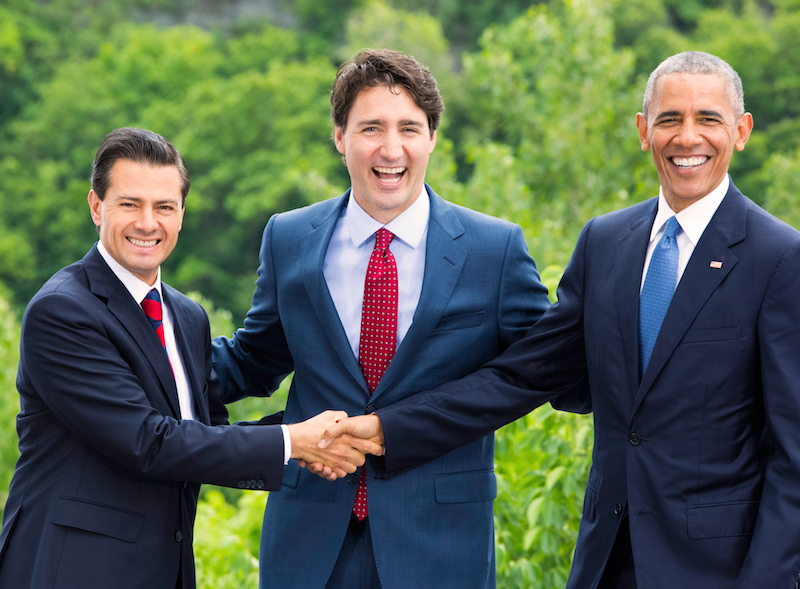The North American Free Trade Agreement (NAFTA) came into effect in 1994. It is known to most people as a trilateral agreement with the purpose of dismantling trade barriers between the three North American countries. The United States, Canada and Mexico constitute a league of nations that together concluded that there were mutual benefits to eliminating tariffs and opening markets for increased trade.
The concept of NAFTA is not too different from the founding principles of the European Union (EU). Increased prosperity, competitiveness and well-being among citizens through economic cooperation were driving forces behind the initiation of both NAFTA and the EU. However, it is important to keep in mind that the North American countries did not agree to the same, high level of interdependence that binds the European community together. The EU embodies the world’s most rigorous institution for trade liberalization, its structure includes an economic union that guarantees the free movement of both goods and people. NAFTA’s purpose is to reduce tariffs between the member states but not commit to a larger agreement on common policy.
Although the different level of economic integration may be the foremost distinguishing feature between the two free trade agreements, it is not the only one. The EU consists of a larger group of participants than NAFTA, 25 more individual countries to be precise, and the union enjoys a stronger common identity than its North American counterpart. The European Commission conducted a Standard Eurobarometer report in 2014 and found that over 60% of Europeans claim to perceive themselves as citizens of the EU. Statistical information of this kind does not seem to exists for the NAFTA countries, which might suggest that a common “North American” identity is a weaker concept.
The authors of the book North American Integration. An institutional Void in Migration, Security and Development argue that the limited shared values between the U.S, Canada and Mexico result in an absence of a sense of “North-Americanness.” The book suggests that the institutional shortcomings of NAFTA and general unwillingness among the three countries to invest in trilateral interdependence have prohibited the formation of a common identity.
NAFTA altered the structures of North American trade relations and was a major step towards bolstering the integration between the governments and economies of Mexico, the U.S and Canada. The ongoing debates on how to reform NAFTA and improve its operational capacity mainly targets job losses, immigration policy and the implications of the Trans Pacific Partnership (TPP), which may come to replace the current trade agreement.
Another topic that has long been in the spotlight, yet does not receive nearly as much attention as the economic aspects of the treaty, is the deficient institutionalization of NAFTA. Political representatives and financial agencies in all three countries have long expressed the need to reshape NAFTA’s institutional design. Politicians who advocate for increased interconnectedness in NAFTA have particularly emphasized the potential benefits of adopting an institutional framework that resembles the one of the European Union.
NAFTA added a trilateral dimension to the relationships between the North American countries that used to be managed bilaterally, but did not result in a desire to transform the continent into a common space. North America is often addressed and conceived as a continent but not as a community. It is important to acknowledge that the U.S, Canada and Mexico are much bigger in size than the member states of the European Union. The geographical separation and more rigorous border control in North America contribute to the cultural disparities between the countries.
U.S hegemony and dominance in the region is another common explanation as to why the three countries do not perceive each other as equals in terms of power and interdependence. The inevitably stronger position of the United States, both economically, militarily and politically, can serve as an overbearing force towards its neighbouring countries and hinder closer assimilation between the parties. The famous line delivered by the Bush administration after the 9/11 terrorist attacks: “you are either with us or against us” were equally directed at Mexico and Canada despite pledging their full support to the U.S after the attacks.
Mutual economic benefits appears to be the main incentive for cooperation between the North American countries. NAFTA serves as a trade agreement that facilitates interaction based on trade and profit extraction, but does not bind North America together as a trilateral space in terms of cultural belonging or a common identity. The focus of the treaty is trade and commercial flows instead of regional mutuality or political integration. Power asymmetry underpins the cooperation and may prohibit prospects of deeper, trilateral interdependence.
Photo: President of Mexico, PM of Canada and President of the United States, (2016), by Presidencia de la República Mexicana via Wikimedia licensed under CC 2.0
Disclaimer: Any views or opinions expressed in articles are solely those of the authors and do not necessarily represent the views of the NATO Association of Canada.




